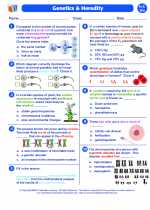Genetics and heredity I -> law of segregation
Law of Segregation Study Guide
Definition:
The Law of Segregation states that each individual diploid organism possesses two alleles for a particular trait, which separate during the formation of gametes, such that each gamete receives only one of the two alleles.
Key Points:
- Genes come in pairs: Organisms inherit two alleles for each trait, one from each parent.
- Alleles segregate during gamete formation: When gametes are produced, each carries only one allele for each trait.
- Random combination at fertilization: When gametes fuse during fertilization, the resulting offspring will have two alleles for each trait, with the specific combination being random.
Mechanism of Segregation:
During the process of meiosis, which is the cell division that produces gametes, the two alleles for each gene separate into different gametes. This occurs during the first stage of meiosis, known as the prophase I, when homologous chromosomes pair up and exchange genetic material through a process called crossing over. As a result, each gamete receives only one allele for each gene, ensuring genetic diversity in the offspring.
Illustrative Example:
Consider a pea plant that is heterozygous for flower color, with one allele for purple flowers (P) and one allele for white flowers (p). According to the Law of Segregation, during gamete formation, the P and p alleles segregate, so that each gamete receives only one of the two alleles. When these gametes combine at fertilization, the resulting offspring will inherit one allele from each parent, resulting in the genetic diversity of flower colors in the next generation.
Significance:
The Law of Segregation provides the basis for understanding how genetic diversity is maintained in populations and how traits are inherited from one generation to the next. It also forms the foundation for the principles of dominance, recessiveness, and genetic inheritance patterns, laying the groundwork for modern genetics and the study of heredity.
[Law Of Segregation] Related Worksheets and Study Guides:
.◂Biology Worksheets and Study Guides High School. Genetics and heredity I

 Worksheet/Answer key
Worksheet/Answer key
 Worksheet/Answer key
Worksheet/Answer key
 Worksheet/Answer key
Worksheet/Answer key
 Vocabulary/Answer key
Vocabulary/Answer key
 Vocabulary/Answer key
Vocabulary/Answer key
 Vocabulary/Answer key
Vocabulary/Answer key
 Vocabulary/Answer key
Vocabulary/Answer key
 Vocabulary/Answer key
Vocabulary/Answer key
 Vocabulary/Answer key
Vocabulary/Answer key
 Vocabulary/Answer key
Vocabulary/Answer key
